











By Kevin M Thomson

























By Kevin M Thomson












By Kevin M Thomson

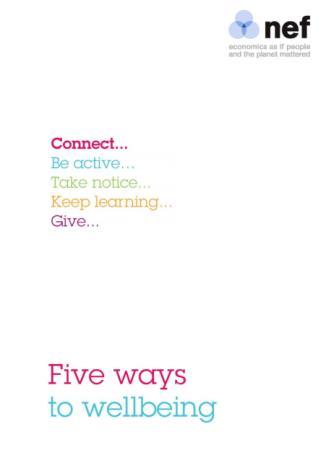
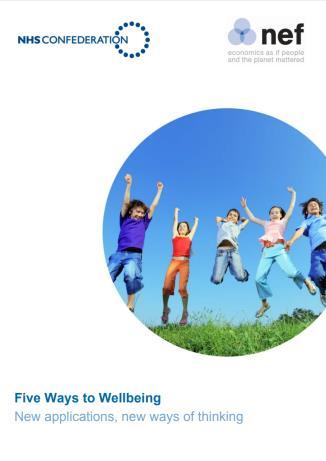
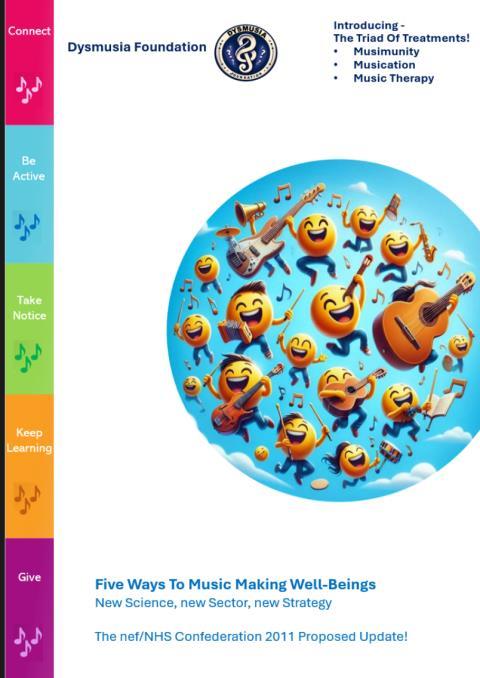








Forward to the Reimagined, Proposed - 5 Ways to Music Making Well-Beings Benchmark By
Kevin M Thomson
&
Sally M Thomson
– Founders Dysmusia.Foundation Prepared for tes SEND Show 2024 – A Labour of Love!
In 2008, the UK Government Futures Thinktank sponsored the nef (New Economics Foundation) Foresight Project, resulting in the globally evidenced '5 Ways to Wellbeing.' This groundbreaking report provided a framework for improving mental health and wellbeing across the population. By 2011, an update supported by the NHS Confederation aimed to enhance the promotion and application of these principles.
Given the widespread adoption of the 5 Ways to Wellbeing globally, this 2024 update seeks to reimagine the original report by incorporating the latest advancements in neuroscience and social neuroscience. The objective is to establish music making as the most significant contributor to global wellness and individual well-being.
We propose the introduction of three levels of Music Making Well-Beings, with two new terms that help understand music making not just as a pleasure or career pursuit, but fundamentally as a 'Health, Wellness & Wellbeings Strategy' (see Wellenomics - The Book). These three terms clarify the levels of Well-Being and un-Wellbeing:
1. Musimunity: This term encapsulates the dual benefits of music making providing immunity against stress, ill-health, and un-wellbeing while fostering unity through social connections.
2. Musication: Refers to the 'free' internal medication that music making brings, mental and emotional health through daily application of the tools, technology, teaching, tutoring and training alongside the self-help or mentor facilitated approaches. This level applies to the 20% of SEND Special Educational Needs, the 90% who never tried or ‘gave up’ (ABRSM) 20% + 90% = 100% who can benefit from the No. 1 Way of Music Making Wellbeings,
3. Music Therapy: Recognised by the Global Wellness Institute (GWI), as a professional intervention i.e at Masters Level - for addressing severe un-wellbeing, highlighting that music therapy is only one level of the overall power of creating Wellsicians and helping prevent un-Wellsicians.
The Triad of Treatments! The Three Levels of Music Making for Well-Beings To further enrich this framework, we introduce three levels of music-based interventions:
1. Musimunity: Utilising the 5 Ways to Music Making Well-Beings as a comprehensive framework to build resistance against un-wellbeing and enhance overall health and wellbeing. Regular engagement in music making whether singing, learning, playing, or performing provides natural boosts of oxytocin, dopamine, endorphins, serotonin, and adrenaline. Music making acts as a form of ‘immunity,’ fostering a more resilient and flourishing state of well-being through social connections.
2. Musication: A self-help, teacher or tutor, parent or caregiver, band-mate or orchestra leaderfacilitated approach that incorporates the 5 Ways to Music Making Well-Beings Framework into everyday life. Tools such as Apps, LMS-type interventions, training programs, and toolkits can be used by music teachers, tutors, parents, mentors, band/choir/orchestra members, and leaders. Musication serves as a form of ‘medication’ for mental health, promoting continuous engagement in music as a therapeutic practice to enhance cognitive and emotional well-being.



3. Music Therapy: For individuals experiencing severe un-wellbeing, professional intervention from trained music therapists is essential. However, with no formal, universal, framework for Music Therapists i.e. that involves the application of the 5 Ways Framework to provide structured, evidence-based interventions that address specific mental health challenges, the need is open for re-imagining the future! Therapists can now guide individuals through 5 Ways Benchmarked with their own tailored music making activities to promote healing, emotional expression, and psychological resilience, forming the foundation for a journey towards becoming a ‘Wellsician’ at the two other levels.









This reimagined report forms part of our broader strategy to establish the 12th Sector of Wellness as a new Economic & Strategic initiative of the Global Wellness Institute (GWI) i.e. Music Making Well-Beings. Our initiative, 'The 5 Ways to Well-Beings,' is structured around five core components:
1. Wellenomics - The Book: Outlines the economic opportunities within the music making wellness sector.
2. The Top 20 TedTalks - The Background: Presents the latest neuroscience research highlighting the cognitive and social benefits of music making.
3. The YouGov Benchmark and 5 Ways to Music Making Well-Beings nef 2024 Update - The Benchmarks: Provides a framework for measuring the impact of music making on well-being.
4. EmojiPhonics - SEND and Non-SEND Multi-Sensory Teaching: Offers tools and methodologies for inclusive music education.
5. Wellness Policy Toolkit: Music Making Well-Beings: Adapts the GWI Physical Activity Toolkit to create a sector-specific guide, highlighting the $4Bn opportunity and £1Tn global wellness impact.
We contextualize "Well-Being" within the framework of the 5 Ways to Wellbeing as defined by nef/UK Government Foresight. This framework includes all 5 Ways – For the 20% SEND, the 90% who never tried or gave up, and the 100% of all who can build on the power of Music Making Health and Wellbeing + help un-Health and un-Wellbeings move to a ‘better place’ through music making.
1. Connect: Building social connections through music making – for all ages and abilities; not just listening to music but actively participating in learning, practicing, playing, and performing. This involves connecting with parents, teachers, tutors, choirs, groups, orchestras, audiences, and community members.
2. Be Active: Engaging in physical activities related to music, such as dancing or playing instruments, benefits both physical and mental health for all abilities and disabilities.
3. Take Notice: Enhancing mindfulness and awareness through musical experiences–engaging in the conscious activity of physical, mental, spiritual, and emotional awareness through music.
4. Keep Learning: Promoting continuous learning and skill development in music – from simple activities like banging a drum or playing ‘the 4 chord trick’ to achieving high levels of proficiency such as performing at Carnegie Hall.



5. Give: Encouraging the sharing of musical talents and resources within families, friends, schools, colleges, clubs, social events, and entire communities.










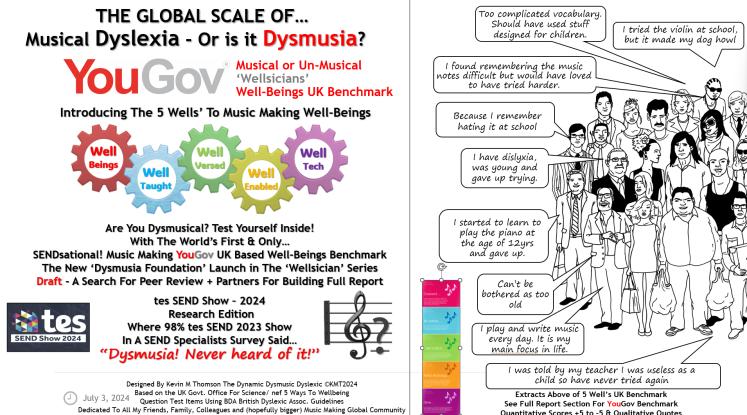

The advent of AI, apps, and LMS software presents significant opportunities for advancing music making well-beings. Key areas include:
1. Benchmarking Music Making Well-Being: Utilizing technology to measure and track the impact of music making on wellness.
2. Personality-Based Music Teaching and Learning: Adapting teaching methods to suit individual learning styles and personality types.
3. Multi-Sensory Musical Tools: Developing tools to aid those with dysmusia and other sensory, mental, physical, emotional, and intellectual challenges in the complex world of music making.
4. Personalized Teaching, Tutoring, and Learning: Leveraging technology to offer tailored music education experiences that are visual, auditory, kinesthetic, fun, colorful, simple, easy, engaging, and exciting.
5. Assistive Learning Tools: Creating tools and teaching aids, such as classroom color sheet music and instruments, to support neurodiverse learners in achieving their musical potential.
By integrating these elements, "Wellenomics of Music Making Well-Beings" provides a comprehensive roadmap for harnessing the transformative power of music making. It aims to inspire a global movement that not only realizes significant economic opportunities but also fosters a profound and lasting impact on individual and collective well-being.



You are invited to join the choir … singing out the future of music making wellness as a global sector and local well-beings.


5. The $4Bn GWI 12th Sector Opportunity







The Wellenomics - of Music Making Global Wellness & Local Well-Beings - this Blueprint is, I believe, (backed by the amassing evidence – herein - I call ‘Rooted in Science!’) a Wellness Revolution: Much like my first book ‘The Employee Revolution – FT Pitman’ which introduced the concept of 'Internal Marketing’ as opposed to ‘employee communication’: In short from an ‘information giving’ methodology of ‘newsletter’ driven ‘comms’ to a ‘marketing’ methodology of targeted user driven ‘messaging’ – this too is truly a revolution – driven both by neuroscience and wellbeing research including the new Dysmusia.Foundation 5 Ways To Music Making Well-Beings YouGov Benchmark.
A ‘revolution’? Yes, not least because there is no Music Making Sector in the GWI only a tiny Music Therapy element; where all the latest Neuroscience on Cognitive Development and now Social Neuroscience of Music Making Social Connection Wellbeing and Happiness (oxytocin et. al!) tells us music making is the No. 1 way to building mental, health and wellbeing - as well as the therapeutic elements of helping un-Wellbeings back to wellness.
This new, globally evidence-based blueprint and outline discussion document for all, I’ve called the Wellenomics of Music Making Well-Beings. I seek to differentiate and bridge the GWI defined concepts of ‘Wellness’ and ‘Wellbeing’ applying these GWI principles contained in each definition to what CHATgpt reveals as the ‘missing opportunity’ of a new 12th Sector of ‘Music Making Well-Being.’
Wellness, as I interpret from the definitions by the Global Wellness Institute (GWI), encompasses the ‘intentions, actions, and activities’ necessary to create Well-Beings within a sector.
It is primarily concerned with the strategic integration of various elements to build a cohesive sector. The Wellenomics approach aims to establish a new 12th sector focused on Music Making Well-Being, integrating and enhancing all existing 11 wellness sectors. This strategic initiative recognizes a $4Bn economic opportunity within the wellness sector, offering a structured and unified approach to harnessing the power of music making a $1Tn economic impact on global wellness.
In contrast, wellbeing pertains to the perception of a state of being, with a prominent mental and emotional dimension. It involves the tactical execution of wellness strategies, focusing on individual and collective health outcomes. "Wellenomics Of Music Making Well-Beings" as a blueprint outlines a comprehensive Wellness Policy Music Making Toolkit, designed to implement these strategies across all wellness sectors, as well as in government, education, health, care, and charitable organizations. This approach aims to leverage the latest advancements in neuroscience and social neuroscience to achieve a £1Tn impact on global health and wellbeing measures.


By differentiating and integrating the concepts of both music making wellness and music making wellbeing, this initiative aims to highlight the differences and needs for creating both a new $4Bn Global Wellness Opportunity for a Music Making Sector- which then results in building a £1Tn Global Wellbeing Impact on individual and collective wellbeing.
The strategic vision for creating this new sector, combined with tactical execution across various domains of wellbeing and music making, sets the stage for a transformative movement in global health and wellness.
I hope this proposal as a discussion document will do 5 things:
1. Make you think about the untapped potential of music making in promoting well-being. 2. Make you believe in the power of music to transform lives.
3. Inspire you to act and incorporate music making into wellness initiatives.
4. Encourage you to deliver programs & policies that make music making accessible to all.
5. Ultimately, ensure that you and those you care for are not just part of the 20% SEND or the 90% who never tried or gave up, but part of the potential 100% who, regardless of skill level from playing a simple 4 Chord Trick to performing at the Royal Albert Hall creating a new World of Wellsicians.
My single simple (yet BIG BOLD) goal with this as a proposal and a discussion document is to inspire you to join me on this journey to harness the holistic benefits of music making, fostering a world where everyone can experience the joy and well-being it brings. Together, we can transform lives through the universal language of music a language we can make into a language of wellness and a tool for making well-beings for every age, young to old, every ability, whether SEND disabled or not, every capacity, academic or physical, and every achievement level desired, from playing for fun, playing by ear, or playing for exams to Grade 8 and beyond for a career.
Warm regards,
Kevin M. Thomson

Wellenomics of Music Making Global Wellness & Local Well-Beings - The Blueprint Book is a groundbreaking book that seeks to differentiate and bridge the concepts of wellness and wellbeing, applying these principles to the ‘missing opportunity’ of a new 12th Sector of ‘Music Making Well-Being.’
Understanding these distinctions, as defined by the Global Wellness Institute (GWI), is crucial for recognizing the potential $4Bn economic ‘opportunity’ within the wellness sector and the profound £1Tn ‘impact’ on global health and wellbeing measures.
In short, this initiative aims to highlight a $4Bn Global Opportunity for a Music Making Sector and a $1Tn Global Impact on all our individual and collective wellbeing.


Wellness, as defined by the GWI, encompasses the ‘intentions, actions, and activities’ necessary to create "Well-Beings" within a sector. It relates to the intention, action, and activities primarily in a business or private industry context, i.e., sector-based. Wellenomics seeks to set out how all 11 existing sectors can integrate music making opportunities under the banner of ‘The Single Biggest Impact on Wellbeing – Of All.’
This integrative approach is pivotal for motivating as well as measuring industry size and identifying business opportunities. In "Wellenomics of Music Making Well-Beings," we define how music making can be integrated into the wellness sector, unlocking a $4Bn opportunity.
We define how this can be done in each of the Wellness Activities and Music Making in its own right via a new proposed version of a Wellness Policy; Music Making Activity Toolkit
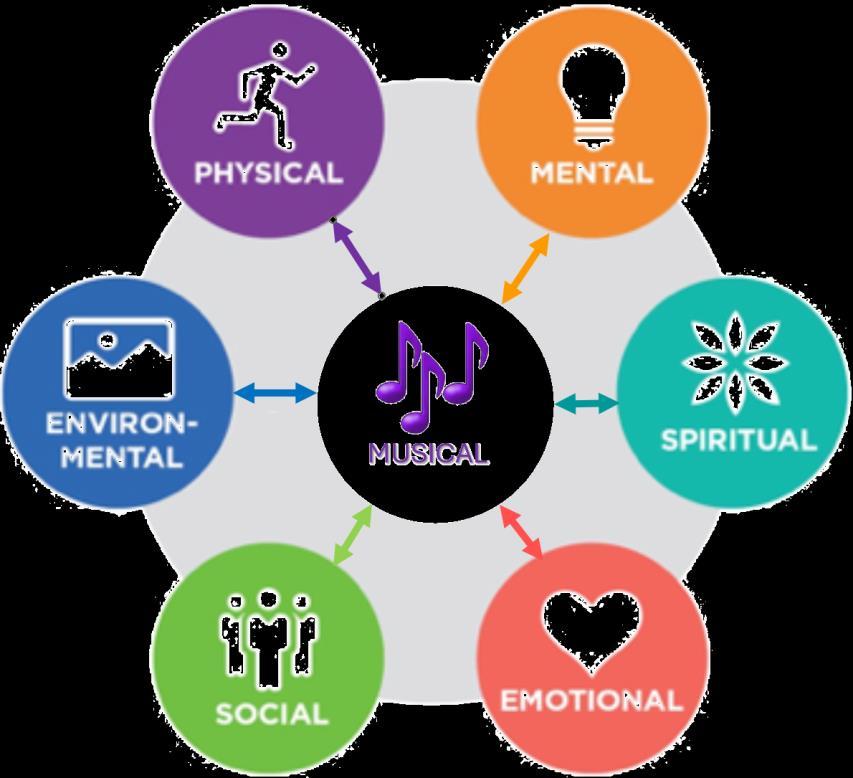

In contrast, wellbeing pertains to the perception of a state of being, with a prominent mental and emotional dimension. It is commonly used in policy and government contexts and is essential for measuring individual and citizen welfare. By leveraging the latest advancements in neuroscience and social neuroscience, the book outlines how music making can significantly impact global wellbeing, with an estimated £1Tn effect on society.
The "5 Ways to Music Making Global Wellness" strategy sets the stage for this transformation. Based on the idea of focusing on five actionable steps similar to the '5-a-day' fruit and vegetable campaign originally from the nef (New Economics Foundation) and the UK Government-sponsored Foresight project of the '5 Ways to Wellbeing,' this approach is detailed on the Wellsician.io website and comprises the following:
1. Well-Being: Defined in "Wellenomics – The Blueprint," this concept outlines the overarching vision, mission, values, and goals of creating a music making-centric wellness sector.
2. Well-Taught: Explores the neuroscience research behind music making's impact on wellness and wellbeing, featuring the Top 20 TedTalks on the subject.
3. Well-Versed: Involves tracking and trending the YouGov 5 Ways to Music Making Wellbeings nef Benchmark, providing insights into how music making influences wellbeing.
4. Well-Enabled: Focuses on the multi-sensory tools and teachings necessary for SEND (Special Educational Needs and Disabilities) and non-SEND individuals to achieve music making as a pathway to wellbeing, despite its complexity.
5. Well-Tech: Highlights the tools and technology required to create multi-modal solutions for all neurodiversity needs, catering to all ages and abilities.


We posit Well-Being within the framework of the 5 Ways to Wellbeing as defined by nef/UK Government Foresight. This framework includes all 5 Ways:
1. Connect: Building social connections through music making for all ages and abilities; not just listening to music but actively participating in learning, practicing, playing, performing, and connecting with parents, teachers, tutors, choirs, groups, orchestras, audiences, and all community members.
2. Be Active: Engaging in physical activities related to music, such as dancing or playing instruments for all abilities and disabilities.
3. Take Notice: Enhancing mindfulness and awareness through musical experiences through the conscious activity of physical, mental, spiritual, and emotional awareness.
4. Keep Learning: Promoting continuous learning and skill development in music to whatever level, from banging a drum or playing the ‘4 chord trick’ to performing at Carnegie Hall dance, sing, play.
5. Give: Encouraging the sharing of musical talents and resources within families, friends, schools, colleges, clubs, social events, and entire communities.






The advent of AI, apps, and LMS software presents significant opportunities for advancing music making well-beings.
Key areas include:
1. Benchmarking Music Making Well-Being: Utilizing technology to measure and track the impact of music making on wellness.
2. Personality-Based Music Teaching and Learning: Adapting teaching methods to suit individual learning styles and personality types.
3. Multi-Sensory Musical All Abilities and Specific Dysmusia Tools: Developing tools to aid those with dysmusia and other sensory, mental, physical, emotional, and intellectual challenges in the complex world of music making.
4. Personalized Teaching, Tutoring, and Learning: Leveraging technology to offer tailored music education experiences visual, auditory, kinesthetic fun, colorful, simple, easy, engaging, exciting, genre-based, academic-level-based, and above all, wellbeing-based.
5. Assistive Learning Tools: Creating tools and teaching aids, such as classroom color sheet music and instruments, to support neurodiverse learners in achieving their musical potential.
By integrating these elements, "Wellenomics of Music Making Well-Beings" provides a comprehensive roadmap for harnessing the transformative power of music making. It aims to inspire a global movement that not only realizes significant economic opportunities but also fosters a profound and lasting impact on individual and collective wellbeing.
You are invited to join the choir singing out the future of music making wellness as a global sector and local well-beings everywhere.

Summation Of A Lifetime of Frustration
Passion For Communication
A Summation Of A Lifetime Of Frustration A Passion For Communication A Realisation Communication IS Wellbeing! And The Dyslexic Dysmusic Mind Of A Dynamic ENTP Dysruptor!

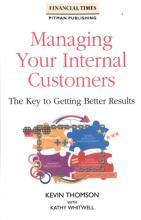






Integrating Music Making into the Global Wellness Institute Definitions The C 21st Neuroscience & Social Neuroscience Revelations – For Us All!
Physical: Nourishing a healthy body through exercise, nutrition, sleep, etc.
- With Music Making: Engaging in physical activities such as playing instruments or dancing to music enhances coordination, motor skills, and overall physical health.
.
Environmental : Fostering positive interrelationships between planetary health and human actions, choices, and wellbeing.
- With Music Making: Music making can raise environmental awareness through community events and sustainabilitythemed music projects, promoting a harmonious relationship with nature.
Mental: Engaging the world through learning, problem-solving, creativity, etc.
- With Music Making: Learning to play an instrument, composing music, or participating in music-related activities stimulates cognitive functions and fosters creativity.

Social: Connecting and engaging with others and our communities in meaningful ways.
- With Music Making: music activities, such as bands, choirs, and community music events, strengthens social bonds and fosters a sense of belonging.
Searching for meaning and higher purpose in human existence.
- With Music Making: Music making can be a spiritual practice that offers a sense of purpose, connection, and fulfilment, and can be incorporated into meditative and reflective practices.
Emotional: Being aware of, accepting, and expressing our feelings, and understanding the feelings of others.
- With Music Making: Music making provides an outlet for emotional expression, helps process feelings, and enhances emotional resilience.
Musical: Enhancing overall wellbeing through active engagement in music making.
- Definition: Music making integrates physical, mental, emotional, spiritual, social, and environmental wellness, providing a comprehensive approach to lifelong health and happiness. Engaging in music making activities, whether individually or in groups, promotes overall wellbeing by fostering creativity, emotional expression, social connections, and a sense of purpose.

By redefining wellness to include music making as an integral element, we recognize the multifaceted benefits of music across all areas of health. This holistic approach to wellness underscores the transformative power of music making, promoting a balanced and enriched life.









Five Ways To Music Making Well-Beings
New Science, new Sector, new Strategy
The nef/NHS Confederation 2011 Proposed Update!





By Kevin M Thomson – Powered By












1. Putting the Five Ways to Wellbeing in Context: By Adding A New Dimension of Music Making Well-Beings - Neuroscience Now Tells Us is The Most Powerful of All Individual Global Wellness Interventions
2011 Perspective - In early 2011, the Department of Health launched the Coalition Government's mental health outcomes strategy, ‘No Health without Mental Health’
The strategy identified two overarching goals:
1. Improve the mental health and wellbeing of the population and keep people well.
2. Improve outcomes for people with mental health problems through high-quality services that are equally accessible to all.
Throughout, No Health without Mental Health emphasized the importance of promoting positive mental health and wellbeing as a key objective for policy and national and local organizations.
The strategy outlined by the coalition government explicitly connected mental health to broader outcomes, not just within health but across various "non-health" policy areas. In the foreword to the new strategy, Secretary of State for Health Andrew Lansley stated:
"The Government recognizes that our mental health is central to our quality of life, central to our economic success, and interdependent with our success in improving education, training, and employment outcomes and tackling some of the persistent problems that scar our society, from homelessness, violence and abuse, to drug use and crime."
This broader perspective on the significance of mental health and wellbeing in the population was also reflected in the public health White Paper, Healthy Lives, Healthy People, which gave equal weight to both physical and mental health.
At a more macro level, the Prime Minister tasked the Office of National Statistics (ONS) with developing a set of indicators to measure national wellbeing.
The direction of travel has been towards a more holistic understanding of mental health that balances promotion and prevention at a population level with care and treatment for those already experiencing difficulties.
This is a significant shift from previous policies, and it is important to consider the reasons behind this change.













First, an argument against a solely "deficit" approach to service delivery is based on financial considerations. Simply put, it is more expensive over the longer term than an approach that includes promotion and prevention.
For instance, one study of children with complex mental health needs found that service costs averaged over £50,000 per year per child, with 90% of these costs falling under education and social service budgets.
While it would be naïve to believe that a more promotive and preventative approach could eliminate the need for targeted interventions and support, research evidence suggests that such an approach, if delivered on a population-wide basis, could lead to substantial cost savings over the medium and long term and better outcomes for people.
Secondly, focusing solely on those experiencing mental health difficultiesdoes not help reduce the overall incidence of deficits and vulnerability in the population. This argument is summarized in Figures 1a and 1b, reproduced from a study by Huppert. Figure 1a shows a hypothetical distribution of mental health across a population. At the right-hand side of the distribution are those experiencing significant mental health difficulties, meeting the criteria for a mental illness diagnosis. Next to this is a group described as languishing people experiencing some difficulties and distress in their daily lives but at a "sub-clinical" level. The majority of the population are assumed to have moderate mental health, and at the left-hand side of the scale is a small group who are truly flourishing.
This model is a simplification, and recent work suggests that mental wellbeing and mental illness may be better conceptualized as two correlated but separate dimensions. Nonetheless, it makes explicit that the opposite of mental ill-health is not merely its absence but the presence of positive psychological states. While a subtle change, this is extremely significant; it suggests a new area of interest for promoting mental health, namely developing interventions and strategies to shift people upwards from languishing and moderate mental health to flourishing.
From the perspective of a population-wide strategy, the model proposes that the mean prevalence of symptoms or risk factors in the population, while below clinical thresholds, is associated with the number of people experiencing significant difficulties and challenges. Empirical evidence supports this observation, leading to the point made in Figure 1b. Strategies and interventions that shift the entire population will increase the number of people flourishing and reduce the number experiencing troubling mental health problems.
These arguments support the approach described in..
of improving mental health and wellbeing at a population level while also targeting those already experiencing difficulties.
But this raises questions: How much is known about positive mental health, and how can it be improved?











Incorporating the Latest Neuroscience and critically.. the Social Neuroscience of Music Making Well-Beings
In this updated 2024 version of the report, we integrate the latest advancements in neuroscience and social neuroscience to underscore music making as a pivotal activity in enhancing global wellness and individual well-being.
By reimagining the original framework, we propose the 5 Ways to Music Making Well-Beings, a comprehensive strategy for creating Wellsicians individuals who thrive through music making.
The 5 Ways to Music Making Well-Beings: Building Wellsicians
1. Connect: Building social connections through music making not just listening, but actively participating in learning, practicing, playing, and performing. This involves connecting with parents, teachers, tutors, choirs, groups, orchestras, audiences, and community members.
2. Be Active: Engaging in physical activities related to music, such as dancing or playing instruments, benefiting both physical and mental health for all abilities and disabilities.
3. Take Notice: Enhancing mindfulness and awareness through musical experiences, engaging in the conscious activity of physical, mental, spiritual, and emotional awareness through music.
4. Keep Learning: Promoting continuous learning and skill development in music from simple activities like banging a drum or playing ‘the 4 chord trick’ to achieving high levels of proficiency such as performing at Carnegie Hall.
5. Give: Encouraging the sharing of musical talents and resources within families, friends, schools, colleges, clubs, social events, and entire communities.











The Triad of Treatments! The Three Levels of Music Making for Well-Beings
So good it’s worth repeating!!!!
Over to you as…
…A self-help, teacher or tutor, parent or caregiver, and mate or orchestra leader -facilitated approach that incorporates the 5 Ways to Music Making Well-Beings Framework into everyday life.
To further enrich this framework, we introduce three levels of music-based interventions:
1. Musimunity: Utilizing the 5 Ways to Music Making Well-Beings as a comprehensive framework to build resistance against un-wellbeing and enhance overall health and wellbeing.
Regular engagement in music making whether singing, learning, playing, or performing—provides natural boosts of oxytocin, dopamine, endorphins, serotonin, and adrenaline. Music making acts as a form of ‘immunity,’ fostering a more resilient and flourishing state of well-being through social connections.
2. Musication: A self-help, teacher or tutor, parent or caregiver, and mate or orchestra leader -facilitated approach that incorporates the 5 Ways to Music Making Well-Beings Framework into everyday life.
Tools such as Apps, LMS-type interventions, training programs, and toolkits can be used by music teachers, tutors, parents, mentors, band/choir/orchestra members, and leaders. Musication serves as a form of ‘medication’ for mental health, promoting continuous engagement in music as a therapeutic practice to enhance cognitive and emotional well-being.
3. Music Therapy: For individuals experiencing severe un-wellbeing, professional intervention from trained music therapists is essential. Music Therapy involves the application of the 5 Ways Framework to provide structured, evidence-based interventions that address specific mental health challenges.
Therapists can guide individuals through tailored music making activities that promote healing, emotional expression, and psychological resilience, forming the foundation for a journey towards becoming a ‘Wellsician.’














Establishing the 12th Sector of the Global Wellness Institute (GWI) Music Sector Economies of Wellness: Music Making Well-Beings Sector
This report forms part of our broader strategy to establish the 12th Sector of the Global Wellness Institute (GWI) music sector Economies of Wellness: Music Making Well-Beings Sector. Our initiative, 'The 5 Ways to Wellsicians,' is structured around five core components:
1. Wellenomics - The Book: Outlines the economic opportunities within the music making wellness sector.
2. The Top 20 TedTalks - The Background: Presents the latest neuroscience research highlighting the cognitive and social benefits of music making.
3. The YouGov Benchmark and 5 Ways to Music Making Well-Beings nef 2024 Update - The Benchmarks: Provides a framework for measuring the impact of music making on wellbeing.
4. EmojiPhonics - SEND and Non-SEND Multi-Sensory Teaching: Offers tools and methodologies for inclusive music education.
5. Wellness Policy Toolkit: Music Making Well-Beings: Adapts the GWI Physical Activity Toolkit to create a sector-specific guide, highlighting the $4Bn opportunity and £1Tn global wellness impact.
By incorporating these updated insights and strategies, we aim to create a comprehensive approach to enhancing global wellness and individual well-being through music making. This reimagined framework not only leverages the latest scientific advancements but also seeks to inspire a global movement towards a more musically enriched and health-focused society.








Notice





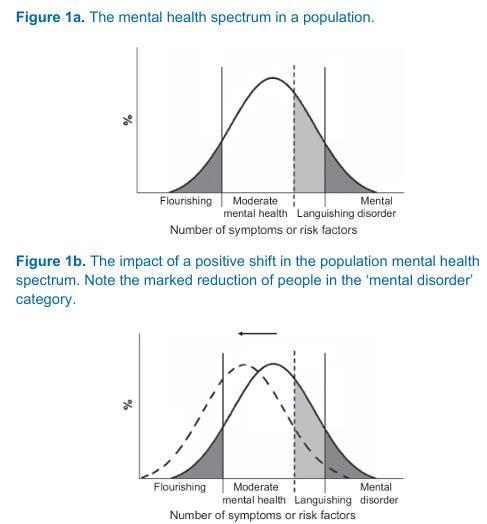
Implications of Positive Mental Health: Music Making Well-Beings and Recent Neuroscience
Following the 2011 Report, a growing body of music-making neuroscience research, particularly in the area of social neuroscience, has explored both the antecedents and consequences of positive psychological states such as contentment and fulfillment often collectively referred to as psychological wellbeing.
Far from being synonymous with the absence of mental health difficulties, psychological wellbeing has both distinct causes and significant implications across a range of outcome areas. Recent studies in the social neuroscience of music making support these outcome areas. For example, research during the COVID-19 pandemic highlighted that “people across the globe have been unable to meet in person, they have found a way to meet in the music” (PsycInfo Database Record, 2022).
For example, people who report higher levels of wellbeing tend to be more involved in social and civic life, are more likely to behave in environmentally responsible ways, have better family and social relationships at home, and are more productive at work. Music making as an activity aligns with all five of The 5 Ways to Wellbeing.
A Music Making Wellbeing update to the extensive 2011 Report recent literature found that wellbeing is positively associated with various positive health outcomes. This adds to the 2011 Report findings that “…increasingly, positive mental states actually precede and help to cause good outcomes in health and wellbeing. For instance, longitudinal studies of wellbeing have shown that the prevalence of good moods predicts working days lost through illness five years later, likelihood of stroke six years later, and of cardiovascular disease ten years later.”
How Can Wellbeing Be Enhanced – By Music Making?...












Implications of Positive Mental Health: Music Making Well-Beings and Recent Neuroscience
Following the 2011 Report, a growing body of music-making neuroscience research, particularly in the area of social neuroscience, has explored both the antecedents and How Can Wellbeing Be Enhanced – By Music Making?
Reflecting academic and policy interest, a large-scale governmental review, the Foresight Project on Mental Capital and Wellbeing, explored the state of knowledge on promoting and maintaining mental capital and wellbeing both now and in the future. The resulting report summarized the available scientific evidence, proposing possible interventions and strategic directions, and outlining options for engagement with leading stakeholders. Here, in this 2024 Music Making update, we propose the specific inclusion of Music Making Neuroscience Research as the basis for the significant introduction of music making into the 5 Ways.
Five Ways to Wellbeing – Time For A Re-Think and Addendum? The 5 Ways To Music Making Well-Beings
The Centre for Wellbeing at nef (the new economics foundation) was commissioned by Foresight to look at the academic evidence that had been gathered and to draw out emergent public health messages concerned with how to promote and maintain positive mental health. The stated intention of the project was to develop a “mental health equivalent” of the popular and well-known message that people should eat five portions of fruit and vegetables a day in order to maintain good physical health.
nef’s subsequent report, Five Ways to Wellbeing: The Evidence, presented five key messages from the review, described in a simple, memorable, and appealing format (see Box 1). The messages were developed to reflect kinds of behavior that people can undertake, and which academic evidence suggests may lead to improvements in their mental health and wellbeing. As such, they differ from some traditional public health messages with a negative focus (i.e., messages telling people what not to do) and help make the point that mental health is determined in part, but not solely, by factors over which individuals have some control.
The Five Ways to Wellbeing was included in the main Foresight project report. In addition, it was printed as a set of colorful postcards.
Time for a New Global Programme of Teaching, Training, Tutoring, and Self Help to Create a World of Wellsicians










Box 1: Five Ways to Wellbeing
Connect…
With the people around you. With family, friends, colleagues, and neighbours. At home, work, school, or in your local community. Think of these as the cornerstones of your life and invest time in developing them. Building these connections will support and enrich you every day.
Music Making Guide:
Form or join a choir, band, or music group. Participate in music-related activities with family and friends. Attend local music events and concerts. Use music as a way to connect with others, share experiences, and build relationships.
Be active…
Go for a walk or run. Step outside. Cycle. Play a game. Garden. Dance. Exercising makes you feel good. Most importantly, discover a physical activity you enjoy and that suits your level of mobility and fitness.
Music Making Guide:
Incorporate movement into your music making. Dance to your favourite tunes, engage in musical games that involve physical activity, or participate in music-related exercise classes like Zumba or drumming workshops. Find joy in combining music with physical activity.
Take notice…
Be curious. Catch sight of the beautiful. Remark on the unusual. Notice the changing seasons. Savor the moment, whether you are walking to work, eating lunch, or talking to friends. Be aware of the world around you and what you are feeling. Reflecting on your experiences will help you appreciate what matters to you.
Music Making Guide:
Immerse yourself in the sounds around you. Notice the melodies of nature, the rhythms of daily life, and the harmonies in conversations. Practice mindfulness through music by listening attentively to different genres and styles. Reflect on how music affects your emotions and experiences.
Keep learning…
Try something new. Rediscover an old interest. Sign up for that course. Take on a different responsibility at work. Fix a bike. Learn to play an instrument or how to cook your favourite food. Set a challenge you will enjoy achieving. Learning new things will make you more confident as well as being fun.
Music Making Guide:
Challenge yourself to learn a new instrument or improve your skills on one you already play. Explore different musical styles and genres. Take music lessons, join a music workshop, or participate in online music courses. Embrace the joy of continuous learning through music.
Give…
Do something nice for a friend or a stranger. Thank someone. Smile. Volunteer your time. Join a community group. Look out, as well as in. Seeing yourself, and your happiness, linked to the wider community can be incredibly rewarding and creates connections with the people around you.
Music Making Guide:
Share your musical talents with others. Perform at community events, volunteer to teach music to children or seniors, or play music for those in need of comfort. Use music as a way to give back to your community and create meaningful connections.
Time for a New Global Programme of Teaching, Training, Tutoring, and Self Help to….
By integrating music making into the 5 Ways to Wellbeing framework, we can create a comprehensive approach to enhancing mental health and wellbeing. This new dimension leverages the latest in neuroscience and social neuroscience to maximize the positive impact of music making on individual and community wellness. It's time to embrace music making as a powerful tool for creating Wellsicians individuals who thrive through the holistic benefits of music.











Since the launch of the (2008) original report, the new 2011 Report says…. “The Five Ways to Wellbeing messages have proven extremely popular. Diverse groups such as General Practitioners, mental health commissioners, arts practitioners, church groups, community and voluntary organizations, and civil service departments have contacted nef to discuss possible applications of the Five Ways to Wellbeing.
Prior to the present report, knowledge about the particular uses people were finding for the Five Ways to Wellbeing was anecdotal. The current project was instigated with two aims:
1. To develop an increased understanding about the scope and potential of the Five Ways to Wellbeing as a tool to improve population mental health and wellbeing.
2. To review how the Five Ways to Wellbeing are currently being used by local and national agencies to help identify future opportunities.”
With the addition of music making, we aim to reimagine the Five Ways to Wellbeing through the lens of Music Making Well-Beings. This new perspective incorporates the latest neuroscience and social neuroscience research to amplify the benefits of music making.
Our
Our mission is to integrate music making into the established Five Ways to Wellbeing framework, thereby enhancing mental health and wellbeing on a global scale. We aim to create a new sector within the Global Wellness Institute (GWI) that recognizes the transformative power of music making.
Our Goals
Our goal is to establish music making as a fundamental practice for improving individual and collective wellbeing. By promoting music making, we aim to:
1. Encourage Social Connections: Use music making to build and strengthen social bonds, creating a sense of community and support.
2. Promote Physical Activity: Integrate physical activity through music-related movements, such as dancing and playing instruments.
3. Enhance Mindfulness and Awareness: Foster mindfulness and awareness through active engagement in music, leading to improved mental health.
4. Facilitate Lifelong Learning: Promote continuous learning and skill development through music education and practice.
5. Encourage Giving and Volunteering: Use music as a means of giving back to the community, through performances, teaching, and participation in community events.
By embedding these principles into the 5 Ways to Music Making Well-Beings initiative, we aim to create a comprehensive approach to mental health and wellbeing that is accessible to all. This initiative not only seeks to address the current gaps in mental health promotion but also to provide a scalable and impactful strategy for global wellness.
### Time for a New Global Programme of Teaching, Training, Tutoring, and Self-Help to Create a World of Wellsicians
The integration of music making into the 5 Ways to Wellbeing framework provides a unique opportunity to revolutionize mental health and wellbeing strategies. By fostering a culture of music making, we can create Wellsicians individuals who thrive through the holistic benefits of music.
This initiative calls for a new global programme focused on teaching, training, tutoring, and self-help, ensuring that everyone, regardless of age, ability, or background, can experience the transformative power of music making.











### Mission and Goal: The 5 Ways to Music Making Well-Beings Initiative
Since the launch of the original report, the Five Ways to Wellbeing messages have proven extremely popular. Diverse groups such as General Practitioners, mental health commissioners, arts practitioners, church groups, community and voluntary organizations, and civil service departments have contacted nef to discuss possible applications of the Five Ways to Wellbeing.
Prior to the present report, knowledge about the particular uses people were finding for the Five Ways to Wellbeing was anecdotal. The current project was instigated with two aims:
1. To develop an increased understanding about the scope and potential of the Five Ways to Wellbeing as a tool to improve population mental health and wellbeing.
2. To review how the Five Ways to Wellbeing are currently being used by local and national agencies to help identify future opportunities.
### New 5 Ways to Well-Beings Perspective
With the addition of music making, we aim to reimagine the Five Ways to Wellbeing through the lens of Music Making Well-Beings. This new perspective incorporates the latest neuroscience and social neuroscience research to amplify the benefits of music making.
#### Mission
Our mission is to integrate music making into the established Five Ways to Wellbeing framework, thereby enhancing mental health and wellbeing on a global scale. We aim to create a new sector within the Global Wellness Institute (GWI) that recognizes the transformative power of music making.
#### Goal
Our goal is to establish music making as a fundamental practice for improving individual and collective wellbeing. By promoting music making, we aim to:
1. Encourage Social Connections: Use music making to build and strengthen social bonds, creating a sense of community and support.
2. Promote Physical Activity: Integrate physical activity through music-related movements, such as dancing and playing instruments.
3. Enhance Mindfulness and Awareness: Foster mindfulness and awareness through active engagement in music, leading to improved mental health.
4. Facilitate Lifelong Learning: Promote continuous learning and skill development through music education and practice.
5. Encourage Giving and Volunteering: Use music as a means of giving back to the community, through performances, teaching, and participation in community events.
By embedding these principles into the 5 Ways to Music Making Well-Beings initiative, we aim to create a comprehensive approach to mental health and wellbeing that is accessible to all. This initiative not only seeks to address the current gaps in mental health promotion but also to provide a scalable and impactful strategy for global wellness.
### Time for a New Global Programme of Teaching, Training, Tutoring, and Self-Help to Create a World of Wellsicians
The integration of music making into the 5 Ways to Wellbeing framework provides a unique opportunity to revolutionize mental health and wellbeing strategies. By fostering a culture of music making, we can create Wellsicians individuals who thrive through the holistic benefits of music.

This initiative calls for a new global programme focused on teaching, training, tutoring, and self-help, ensuring that everyone, regardless of age, ability, or background, can experience the transformative power of music making.










3. A framework for analysis A key objective of the current research was to develop an analytical framework for understanding how people have used the Five Ways to Wellbeing. In this section we present the framework and describe its characteristics in detail. The analytical framework The analytical framework is given in Figure 2. The framework has been designed as a matrix that can be populated with examples of current uses of the Five Ways to Wellbeing and, in so doing, can also highlight gaps in usage. The framework has two dimensions. The first represents the Point of Intervention at which an initiative or activity may be implemented in order to lead to improved wellbeing. The second represents the Principal Purpose of the initiative or activity. Dimension 1: Point of Intervention Most of the scientific evidence underpinning the Five Ways to Wellbeing is based on individual actions. In other words, wellbeing benefits are assumed to accrue to people who spend more time socialising with friends, being physically active, learning new things and so on. The implication is that improving wellbeing requires behaviour change – i.e. people doing more Five-Ways-type activities day-to-day. Research in applied psychology has led to the development of numerous conceptual models of the process through which behaviour change can come about, such as Transtheoretical model – also known as the stages ofchange model20 – and the Theory of Planned Behaviour21. Although there are many others a common feature of virtually all of behaviour change models is that they presuppose the change in question to be – at least to some degree – intentional on the part of the individual. To that end, they have tended to focus on the mental processes that are assumed to underlie successful behaviour change and pay less attention to the role of the external circumstances, be they physical, social, or economic. But, of course, external circumstances are important in shaping behaviour. A person who lives in an isolated rural area may find it more difficult to meet up with friends regularly than one who lives on a busy city estate. Someone with a full-time job and a young family may find that their opportunities for volunteering are limited by time and financial pressures. In these kinds of examples, behaviour change might feasibly be achieved without the need for conscious motivation on the part of the individuals; rather, the change could be achieved by altering the circumstances in which people live. 11 Five Ways to Wellbeing Upstream and downstream interventions Social psychologists have characterised these different approaches to changing people‟s behaviour as, respectively, downstream and upstream.22 Downstream interventions are those where the point of intervention is the individual; that is, they rely principally on motivating individuals to make changes of their own volition. Upstream interventions, by contrast, “focus on changing the environment in which … behaviour occurs and on promoting alternatives”.23 This could mean paying attention to default choices, removing barriers or providing services in such a way that they encourage more positive behaviours. Upstream interventions to improve wellbeing could be enacted on a number of different levels. At a macro-level, strategic decisions about economic, social, and environmental policy influence the background context within which people go about their daily lives. In principle, it would be possible to enact policies affecting the whole population (or significant groups within it) with the explicit intention of promoting wellbeing, perhaps by restricting or mandating certain kinds of activity, or by incentivising and/or lifting barriers to Five-Ways-type behaviours. However, there are also upstream interventions where the principal actor is neither the individual nor a policy-maker taking high-level strategic decisions. Although there are a host of possibilities here, for the purposes of the framework we identify two broad categories of upstream interventions: community and organisation. Taking the latter first, within an organisation, decisions can be made that affect all employees, or all people who interact with the organisation. An organisation with a significant public-facing element – for instance, the social service department of a local authority – could examine its processes and look for ways to increase opportunities for promoting wellbeing in the way that it deals with clients. In cases such as these, the intervention affects the individual but it does not necessarily require them to make self motivated changes to their behaviour.











The Community category encompasses interventions that affect people. Community focus on removing barriers, shifting the social environment to foster the conditions that enable people to engage in more Five actors is wide. For instance, a voluntary organisation providing post mothers could use the Five Ways to Wellbeing to tailor its provision, perhaps by emphasising opportunities for meeting new people and skill sharing, or by incorporating physical activity into its programme. It is important to note that, in practice, many upstream interventions that aim to target wellbeing will have a downstream element. Changing the opportunities that people have to pursue Five-Ways-type activities may be enough to initiate behaviour change in itself, but may require some degree of explicit educational or motivational work with individuals (i.e. downstream intervention) in order to help them make use of opportunities. In summary, the point of intervention dimension of the framework aims to reflect how improvements to wellbeing are assumed to occur as the result of using the Five Ways to Wellbeing downstream or upstream. Dimension 2: Principal Purpose The second dimension of the framework, Principal Purpose, turns on whether improving wellbeing is regarded as the main objective of the policy or initiative in question, or whether insights about wellbeing are being used in order to meet some other objective, albeit with improved wellbeing as a desirable secondary outcome. The former could be described as direct wellbeing promotion – it aims to promote wellbeing directly. The latter could be referred to as taking an indirect approach – it recognises the value of wellbeing and makes use of evidence to inform how services are designed, but it is not primarily a strategy to promote wellbeing. Virtually all policy decisions will have at least some impact on someone ‟s psychological wellbeing at some point. To give an example, consider the case of self-directed support in adult social care. In this approach, service users are allocated a personal budget that they can spend – within some broad constraints – in any way they wish in order to procure the kinds of support that best suit them and their lifestyle. Evidently, employing this model of delivery does not change the overall objectives of adult social services, which remain as they ever were: to provide those in need with the support they require in a way that is effective and efficient. However, evidence from the scientific literature suggests that increasing people‟s control and choice over their own lives is likely to be beneficial to their wellbeing in various ways – hence, it may be reasonable to expect that an indirect benefit of self-directed support may be improved wellbeing amongst those who use it. An intervention might be developed precisely in order to promote positive mental health; a mental health awareness campaign based around the Five Ways to Wellbeing would be such an example. However, it is evident that people engage in FiveWays-type activities for all kinds of reasons and in all kinds of circumstances. On the whole, people do not forge social connections or take part in exercise activities because they are trying to improve their mental health. Rather, they socialise every day at work, take up exercise to lose weight or improve their fitness, attend adult education classes to improve their job prospects, and so on. It seems, therefore, that 14 Five Ways to Wellbeing there is scope for using the Five Ways to Wellbeing as a means of integrating an understanding of wellbeing into the design of interventions, programmes and strategies that are ostensibly aimed at achieving other outcomes. The Principal Purpose dimension of the framework seeks, therefore, to reflect the primary goal of the activity or intervention in question. It asks whether the major purpose is to improve wellbeing, or whether the Five Ways to Wellbeing is being used to improve wellbeing as a secondary aim of existing activity.

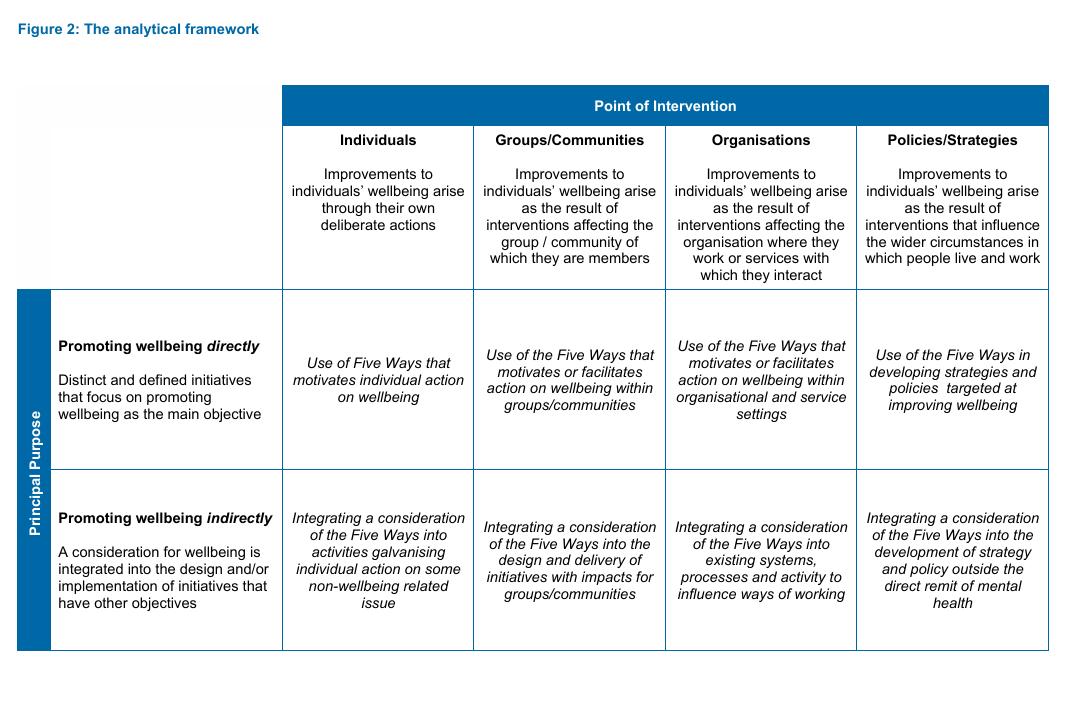










Overview Within the 58 returned surveys, we identified 76 discrete applications of the Five Ways to Wellbeing. Some survey respondents were using the Five Ways to Wellbeing in more than one way and we mapped these uses to the framework explained in the previous section. The results are represented in Figure 3. Each element of the matrix has been given a colour indicating the frequency with which we mapped a use of the Five Ways to Wellbeing to its description: the darker the blue, the greater the number of uses. As the figure illustrates, survey respondents reported using the Five Ways to Wellbeing in a wide variety of ways; both “downstream” and “upstream”, and with wellbeing promotion as both the primary and secondary aim of reported activities. To summarise some general observations: Viewed overall, attempts to increase Five-Ways-type activity were evident at all levels of the point of intervention dimension, i.e.: the individual level, the collective/group level, the organisational level, and the strategic level. Within this range, however, it is clear that certain kinds of activity were more prevalent at some levels than others. Respondents were most likely to be working in a way that aims to encourage individuals‟ to change their behaviour in order to improve wellbeing. Use of the Five Ways to Wellbeing to shape policies and strategies was also quite common, with the number of instances of activity at the strategic level about half that reported at the individual level. The Five Ways to Wellbeing was also used at the organisational level, particularly to affect a change to the work environment through raising awareness. Examples of activity at the group/community level were least common. In relation to the Principal Purpose (direct and indirect approach) dimension, the distribution of uses across the matrix is heavily skewed towards initiatives using the Five Ways to Wellbeing to directly improve or promote wellbeing. These initiatives were six times more common than initiatives that used the Five Ways to Wellbeing to integrate a consideration for wellbeing into other objectives and aims. In the following section, we take a closer look at the interaction between the two dimensions of the framework. Taking the Principal Purpose dimension 16 Five Ways to Wellbeing as our starting point, we first consider how projects and programmes have used the Five Ways to Wellbeing in order to promote wellbeing at the individual, community, organisational and policy level. Secondly, we consider how the Five Ways to Wellbeing can be integrated into processes and ways of working at each of these levels. Using the Five Ways in distinct projects and programmes aiming to promote wellbeing We found the majority of uses of the Five Ways to Wellbeing are downstream and focus on encouraging individuals to take action. In these cases, therefore, impact and success depend on effectively motivating individuals to make changes of their own volition. Encouraging individual action Thirty-seven of the 76 examples corresponded most coherently to this element of the matrix. The Five Ways to Wellbeing was communicated to individuals and groups through various means, including: campaigns; events and festivals; social marketing drives; literacy tools; and healthy lifestyles advice. The focus was generally on information provision and knowledge transfer with the aim of motivating individuals to take action themselves. Raising awareness and literacy levels about wellbeing was a key element of most activities using the Five Ways to Wellbeing in this way. It was also common to find the Five Ways to Wellbeing explicitly linked to existing service provision run by local providers, as a way of increasing uptake and enabling people to self-manage their wellbeing. Typical outcomes for these projects included: Raising the profile of wellbeing in the public consciousness. Making improvements to population-wide mental health. Supporting individuals to take action to improve their own wellbeing. .




















The actual means by which the Five Ways to Wellbeing was used to engage and motivate people tended to differ along three spectrums: 1. Targeted Population-wide The Five Ways to Wellbeing was used to motivate behaviour change in individuals across a number of different settings, including service settings, work environments and communities. Almost half of the examples used the Five Ways to Wellbeing in projects targeted at specific population groups. These groups varied from project to project and included older people, young people, South Asian females, people with disabilities, people with severe and enduring mental health problems, carers, people with pre clinical dementia, social housing tenants, pregnant women, new mothers, the unemployed, staff and volunteers. Other projects worked at the population level with initiatives aimed at engaging the general public, either through community events, local radio, public spaces like museums or galleries and universal settings like GP surgeries. Approximately a third of examples reported working at both the targeted and the population level. 2. Small scale large scale Projects also varied according to scale. This spectrum is not completely unrelated to those whom projects are aiming to influence. Sometimes initiatives were relatively low-key, run in a community centre, a GP surgery, or a particular work setting. Other initiatives took place in more public settings, with higher footfall. The use of the Five Ways to Wellbeing in gallery and museum exhibits in Manchester opened up the possibility of 125,000 visitors engaging with the messages. Large-scale initiatives tended to rely on greater resources to run sustained campaigns and events over a prolonged period of time. As with Liverpool‟ s 2010 Year of Health and Wellbeing, these initiatives pull in a whole range of partners who agree to participate and contribute, especially when backed by senior management in local authorities and health partners (Box 2). 3. Passive Active For the majority of projects and programmes using the Five Ways to Wellbeing to encourage individual action, information and advice was provided by statutory and voluntary providers with the hope that it would be absorbed and acted upon; however, the individual remained relatively passive in the process. This follows a very didactic approach to learning. At the most, initiatives can hope for a shift in understanding but a change in behaviour is probably unlikely. Even if increasing wellbeing awareness is the first step, evidence on the impact of experiential learning provides reason to suspect that active engagement – i.e. learning by doing – might be more effective at increasing understanding, at least for some people.24 Some projects did actively involve individuals and groups in the design of materials. One project worked with students from four schools to create and publish two children‟ s books based on the Five Ways to Wellbeing. One initiative in Cumbria is asking people to do the work – they are opening a temporary exhibition space around the Five Ways to Wellbeing which local people are shaping through the objects, messages, and photos that they choose to display. A rural development project in Scotland is funding and supporting communities to work with the Five Ways to Wellbeing to celebrate life in the community as a mechanism for improving community functioning (Box 3). Where initiatives use both educational messages and activities designed to enhance wellbeing at the point of engagement with a project or programme, they could be working towards dual objectives. A community festival that raises awareness about the Five Ways to Wellbeing while simultaneously providing opportunities for people to connect, learn, or give is one example. As well as being a vehicle for communicating wellbeing messages when labelled or advertised as Five Ways, these initiatives are also providing opportunities for people to go about activities that promote their wellbeing. This feature has some similarities with initiatives working at the group level to create an environment which removes barriers for individuals to take part in Five Ways to Wellbeing activities.









The actual means by which the Five Ways to Wellbeing was used to engage and motivate people tended to differ along three spectrums: 1. Targeted Population-wide The Five Ways to Wellbeing was used to motivate behaviour change in individuals across a number of different settings, including service settings, work environments and communities. Almost half of the examples used the Five Ways to Wellbeing in projects targeted at specific population groups. These groups varied from project to project and included older people, young people, South Asian females, people with disabilities, people with severe and enduring mental health problems, carers, people with pre clinical dementia, social housing tenants, pregnant women, new mothers, the unemployed, staff and volunteers. Other projects worked at the population level with initiatives aimed at engaging the general public, either through community events, local radio, public spaces like museums or galleries and universal settings like GP surgeries. Approximately a third of examples reported working at both the targeted and the population level. 2. Small scale large scale Projects also varied according to scale. This spectrum is not completely unrelated to those whom projects are aiming to influence. Sometimes initiatives were relatively low-key, run in a community centre, a GP surgery, or a particular work setting. Other initiatives took place in more public settings, with higher footfall. The use of the Five Ways to Wellbeing in gallery and museum exhibits in Manchester opened up the possibility of 125,000 visitors engaging with the messages. Large-scale initiatives tended to rely on greater resources to run sustained campaigns and events over a prolonged period of time. As with Liverpool‟ s 2010 Year of Health and Wellbeing, these initiatives pull in a whole range of partners who agree to participate and contribute, especially when backed by senior management in local authorities and health partners (Box 2). 3. Passive Active For the majority of projects and programmes using the Five Ways to Wellbeing to encourage individual action, information and advice was provided by statutory and voluntary providers with the hope that it would be absorbed and acted upon; however, the individual remained relatively passive in the process. This follows a very didactic approach to learning. At the most, initiatives can hope for a shift in understanding but a change in behaviour is probably unlikely. Even if increasing wellbeing awareness is the first step, evidence on the impact of experiential learning provides reason to suspect that active engagement – i.e. learning by doing – might be more effective at increasing understanding, at least for some people.24 Some projects did actively involve individuals and groups in the design of materials. One project worked with students from four schools to .













Efforts to transfer knowledge to other organisations to make them wellbeing aware, included the active dissemination of the messages and the supporting evidence base to third sector organisations, health organisations and local businesses in the case of Liverpool PCT (Box 2). Given the commissioning responsibilities assigned to GPs, it was interesting to record efforts to raise awareness of wellbeing in primary care settings. Some NHS organisations were using the Five Ways to Wellbeing to work with health trainers and GPs directly to emphasise the importance of good mental health. For example: Improving GP’s wellbeing A psychiatrist at the Devon Partnership NHS Trust has developed a workshop that begins conversations with GPs about their own wellbeing. The premise is that if they value their own wellbeing, they may act more intentionally to support the wellbeing of people they interact with through their work (Box 4). Using the Five Ways with health trainers In NHS West Midlands, a number of training sessions informed by the Five Ways to Wellbeing have been developed for health trainers and primary care mental health staff. As part of the training, staff are asked to carry out a mapping activity to identify what they currently do and what they could do to promote each of the Five Ways to Wellbeing through their interventions and client interactions. If and when these and other similar initiatives begin to use the Five Ways to Wellbeing to influence service delivery processes, they will increasingly cross over into the indirect/integration dimension of the framework because they are using the evidence of improving wellbeing to deliver their core objectives: efficient and effective services. 23 Five Ways to Wellbeing











5. Exploring project characteristics In order to better understand the nature of initiatives, the survey asked a number of additional questions. These were designed to explore the relationship of the Five Ways to Wellbeing activity to the work of other local organisations and other wellbeing promotion work more generally. We also wanted to identify the extent to which initiatives were being measured for improvements in wellbeing. Lastly, we asked respondents what would help them to use wellbeing messages more effectively in the future. Partnership working In general, most uses of the Five Ways to Wellbeing were carried out in partnership between organisations, even if one organisation was the lead. In total there were just over 40 examples of Five Ways to Wellbeing activity being led by NHS organisations and only two examples where an NHS organisation was not working in partnership on an initiative. The majority of partnerships were with local organisations (local authorities, third sector or businesses) with some connecting to strategic health bodies and public health networks. It was often the case that NHS organisations were working with several different partners in the coordination of a single initiative. In the main, it seemed that significant work had gone into fostering connections with other organisations in the delivery of this agenda. At the strategic level, partnerships formed the basis of mental health strategies. Of the 11 examples of Five Ways to Wellbeing activity led by local authorities, the majority worked with other partners including NHS organisations, schools, colleges, healthy living networks and leisure services. Of the 13 led by third sector organisations, only two had not worked with other partners. Third sector organisations tended to work with other voluntary and community sector organisations, social enterprises and universities, and in one case a local GP practice. Regional and sub regional structures were particularly good at working with a whole range of organisations, networks and alliances.









Measurement Commitment to measuring improvements in wellbeing as a result of a Five Ways to Wellbeing activity was mixed. Given the varied nature of the activity, measurement approaches also differed greatly. Most respondents had considered measurement, but only a limited number were explicitly measuring changes in wellbeing. Only five respondents replied that they were not measuring any impact, although a further 12 reported that measures were in development. On the whole measurement was ongoing, with the majority of initiatives still 31 Five Ways to Wellbeing underway at the time of the survey and a number of initiatives being assessed as part of wider project evaluations. Generally, though, evaluations did not always seem to entail the measurement of subjective wellbeing; and many of the project evaluations seemed to be qualitative in nature. Campaigns were being measured on outputs such as recognition and hits to websites and increased uptake of services linked to the Five Ways to Wellbeing messaging. More strategic action seemed to be measured by progress against action plans. Of the 12 uses of the Five Ways to Wellbeing which were being specifically measured against subjective wellbeing outcomes, the majority were using the Warwick Edinburgh Mental Wellbeing Scale (WEMWBS). In three cases, this approach was supported by a life satisfaction measure, a lifestyle survey and qualitative feedback. Other approaches to measuring wellbeing that were mentioned included: Qualitative feedback questionnaires on mental health analysed for evidence of the Five Ways. The life satisfaction ladder tool. A 1–10 scale showing how people felt before and after a session. Only a few respondents mentioned the intention to measure before and after an intervention to get some assessment of distance travelled. Only one project mentioned measures being taken three months following contact with the project, in an attempt to track any lasting impact. One project – the Paxton Green time bank – reported having completed a Mental Wellbeing Impact Assessment31, presumably to identify the potential for wellbeing gains at the outset of the project. It seemed that measurement was an area of implementation in which projects and programmes were least confident. Several projects were working with universities to devise measurement and evaluation criteria, whilst a few specifically asked in their survey responses whether nef could provide any available information on baseline questionnaires and assessments. Use of other wellbeing messages Approximately half the respondents reported using other wellbeing messages alongside the Five Ways to Wellbeing in their work. These tended to differ from project to project. Links to public health campaigns A few respondents reported linking the Five Ways to Wellbeing to existing physical health campaigns. For example, one respondent mentioned the link between alcohol prevention and how being active, connecting and learning can support a person to reduce her or his alcohol intake. Two respondents reported linking the Five Ways to Wellbeing directly to the NHS‟s Change4Life campaign32 while others mentioned using messages on healthy eating and physical activity.













Mental health Other messages were oriented more closely to mental health. These included the use of cognitive behavioural therapy concepts, building resilience, skills for developing optimism, creativity, the importance of gratitude and US psychologist Martin Seligman‟ s three factors underpinning a good life – positive emotion, positive engagement and positive meaning.33 One respondent mentioned drawing links between the Five Ways to Wellbeing and the work of sociologist Corey Keyes, who argues for a “dual continua” model of mental health.34 In this approach, mental health and wellbeing are conceptualised as being separate dimensions from mental illness, allowing for the possibility that people with no mental health problems can still have low wellbeing (“languishing”, in Keyes‟ terminology) whereas, conversely, those with significant mental health difficulties may also experience high wellbeing. Social determinants of health Reference was also made to the social determinants of mental health, with one respondent mentioning that they use the Five Ways to Wellbeing as well as the ideas of good work, a decent place to live, equality, financial control, involvement and physical health when they talk about wellbeing. Another respondent mentioned using the Five Ways to Wellbeing with the concept of a mindful employer and another still reported the use of culturally appropriate messages in conjunction with the Five Ways to Wellbeing when working with young black men. Factors supporting use of wellbeing messages The survey asked people to identify anything that would help them use wellbeing messages more effectively in their work. A few respondents focused on the next steps they could take to improve use and effectiveness, mainly in terms of the development of materials. The majority of responses considered actions that could be taken externally. The responses can usefully be summarised as follows:
Access to resources While funding was specifically mentioned as supporting the development of activity and long-term evaluations, most respondents referred to the importance of having affordable or free access to promotional material relating to the Five Ways to Wellbeing. Some respondents reflected on the use they would get out of new materials, and ideas were suggested for additional development. These included Five Ways to Wellbeing business cards that people could carry with them at all times, posters, visual materials, media graphics, a logo, short questionnaires, quizzes and handouts. One respondent suggested that while they could develop these locally, doing so nationally may be more cost-effective. It is also evident that many organisations have designed their own promotional materials using the Five Ways to Wellbeing messages. Promotion at national level It was considered that greater promotion of the Five Ways to Wellbeing at national level would add value to local work, particularly if the Five Ways to Wellbeing was to become as widely known as the „five-a-day‟ nutrition message. The aim would be to create a shift in population awareness and understanding which would contribute to the receptivity and legitimacy of initiatives at local level. Respondents identified social marketing and specific campaigns around the Five Ways to Wellbeing as particularly 33 Five Ways to Wellbeing helpful in raising awareness and developing a common currency around wellbeing. Public spaces which could display promotional material like buses, trains, motorway services and supermarkets were suggested. The linking of wellbeing promotion to national events or particular sectors was also mentioned. The 2012 games were identified as an opportunity to develop “be active”, for example in the North West region as part of the “Decade of Health and Wellbeing” initiative. Promoting the message that wellbeing at work is directly good for business and worth the investment was also identified as a campaign which had national relevance. Despite recognising the added value of a national campaign, one respondent reflected that this should not necessarily be a priority in light of spending cuts. But the need for clarity was emphasised by another respondent who reflected that there is a lot of misinformation and conflicting news about wellbeing, so the general public and even some professionals are unsure what to believe. This can make it easy to avoid taking action. In contrast, a national campaign based on the evidence could provide the impetus to promote wellbeing locally.











Development of policy Some respondents identified that a shift in policy would better support their work to promote wellbeing. In particular, the need for a shift from treatment to a promotion and preventative system where policy nurtures factors which positively affect population wellbeing. Another respondent requested help trying to influence the commissioning process in the context of the NHS reforms and the Big Society agenda. In particular, there were concerns about the need to “sell” the benefits of good wellbeing in the current spending context. It was felt that the case for funding culture, arts and creativity to support wellbeing (both in recovery from mental and physical illness and in maintaining wellbeing) alongside other medical and community services was one that needed to be made. Another big challenge identified by respondents was getting a long-term commitment to support wellbeing. In using the Five Ways to Wellbeing as a framework to support cultural change, one respondent mentioned how difficult it can be to get traction. A logo which could act as a “kitemark” for organisations and workplaces offering activities that improve wellbeing was specifically suggested. Establishing and clarifying the links between wellbeing and asset-based approaches to service delivery was another specific area of policy identified for development. Greater integration Some respondents reflected that their work would be better supported and enabled if the Five Ways to Wellbeing and an understanding of wellbeing more generally were better integrated into ways of working. For example, it was suggested by respondents that the Five Ways to Wellbeing be embedded into local strategies, made to be everybody‟s business and a standard requirement when preparing business cases and service evaluations. Integration of the messages into service design as well as across settings was also mentioned. Respondents identified the usefulness of case studies and examples illustrating good delivery, use with different target groups and evaluation techniques. Some respondents specifically mentioned the idea of a toolkit or formal guidance which could provide inspiration and standards to aspire to. Templates of initiatives and activities were also mentioned alongside 34 Five Ways to Wellbeing insights about approaches most likely to lead to action on the part of community members. Tailored messages Thinking about how to adopt different interpretations of the Five Ways to Wellbeing for different circumstances and population groups was identified as an area for development. This was seen as particularly important for enabling organisations and the public to make a link between wellbeing and people‟s experiences at work or in day-to-day life, more generally.












6. Discussion and conclusions The Five Ways to Wellbeing was developed based on evidence relating to individuals‟ behaviour. If individuals change their behaviour so as to incorporate more Five-Ways-type activities into their day-to-day lives, the empirical evidence suggests that their subjective wellbeing should improve. However, this does not mean that the focus of interventions need always be the individual. As the examples in the survey responses show, there is considerable scope for using the Five Ways to Wellbeing to improve collective wellbeing in a more strategic and indirect way, both in terms of affecting the wider circumstances in which people live to promote wellbeing and by informing processes and ways of working more generally. Within the scope of our project we could not hope to be fully comprehensive, nor can we claim that the projects and initiatives we found are a truly representative sample of the ways in which the Five Ways to Wellbeing has been used since its publication in 2008. Furthermore, whilst it is possible to think of hypothetical examples of projects and initiatives that could fall within each section of the matrix, there is no reason that we should expect uses of the Five Ways to Wellbeing to be equally distributed across the matrix. But if we assume that the relative distribution of responses within the framework analysis is roughly indicative of the wider picture, what observations can we make? The following are three key observations. Taking a wellbeing approach: The Principal Purpose dimension In many cases, there is probably scope for moving from the direct approach, the “top” half of the framework to the indirect approach at the “bottom”, i.e. from using the Five Ways to Wellbeing as the basis for explicit mental health promotion interventions towards using them to integrate an understanding of wellbeing into existing activities. Achieving this shift means thinking about how wellbeing gains can flow indirectly from existing activities and initiatives. In turn, this means thinking about wellbeing as an approach to doing things, rather than – necessarily – the main goal or outcome. There are a number of ways that this might be achieved. For instance, Local Authorities could incorporate outcomes based on the Five Ways to Wellbeing into the commissioning specifications for all kinds of services, not just the obvious areas of mental health and adult social care. A number of ideas along these lines (although not focusing on the Five Ways to Wellbeing in particular) are described in nef‟ s report for Local Government Improvement and Development.35 36 Five Ways to Wellbeing Beyond the individual: the Point of Intervention dimension As noted, the evidence underpinning the Five Ways to Wellbeing is at the level of the individual. Some of the initiatives reviewed described themselves as promoting community flourishing. However, there was a relative paucity of examples where the actual point of intervention was demonstrably at a group level. The concept of community wellbeing is, at present, somewhat under developed and underevidenced in the academic literature. It would be interesting for further research and development to explore whether the Five Ways to Wellbeing is a useful way to think about flourishing communities. Is there, for instance, evidence that improvements in individuals‟ wellbeing within a certain community result in improvements in community-level outcomes? Such evidence, if it existed, would support the intuition of many local policymakers that the wellbeing agenda is more likely to have a positive impact if focused at the community level rather than at individuals.36 Related to this, although the Five Ways to Wellbeing has been adapted on an ad hoc basis for use with a range of different stakeholders, to date there has been no systematic work to test its acceptability with different groups. For instance, it may be that the messaging needs to be adapted for use with certain BME groups, or people with particular health needs. Measuring outcomes and effectiveness It is clear that many of the projects considered in this report would benefit from a more integrated and thorough approach to measurement. Whilst the Five Ways to Wellbeing themselves are evidence-based, in future there will be a need for robust evaluations of their implementation and application. To put it plainly, whilst the survey described earlier tells us something about the ways in which the Five Ways to Wellbeing can be used, it tells us nothing about which uses are more or less effective in improving wellbeing. Ultimately, it may be that this is best achieved through the provision of “best practice” advice and support delivered through the new public health infrastructure (i.e. Public Health England and/or the health and wellbeing boards). Improving measurement and evaluation could also be helped, in part, by the development of a specific Five Ways to Wellbeing measurement tool. Such a tool would support but not replace existing instruments designed to measure population subjective wellbeing (such as the WEMWBS), since it would likely focus on assessing the frequency and nature of Five-Ways-type activities rather than people‟ s feelings per se. In addition it would be useful to develop some general support material on how to measure the effectiveness of interventions that make use of the Five Ways to Wellbeing, in terms of outcomes/distance travelled. Many of the organisations currently using the Five Ways to Wellbeing are more action focused rather than research-focused and may need support in order to set-up sufficiently rigorous project evaluations.
.










Endnotes 1Foresight. (2008). Foresight Mental Capital and Wellbeing Project: Final Project Report. London: The Government Office for Science. Retrieved from: http://www.bis.gov.uk/foresight/our-work/projects/current-projects/mental-capital andwellbeing 2NMHDU operated from April 2009 until the end of March 2011. Information on NMHDU‟s work on public mental health and wellbeing is available at www.nmhdu.org.uk 3Department of Health. (2011). No Health without Mental Health: A Cross Government Mental Health Outcomes Strategy for People of All Ages. London: HM Government. p. 5. 4Ibid. 5Department of Health. (2010). Healthy Lives, Healthy People: Our Strategy for Public Health in England. London: HM Government. 6Clark, A., O‟Malley, A., Woodham, A., Barrett, B., & Byford, S. (2005). Children with complex mental health problems: needs, costs and predictors over one year. Child and Adolescent Mental Health, 10, 170-178. 7Huppert, F. A. (2009). A new approach to reducing disorder and improving wellbeing. Perspectives on Psychological Science, 4, 108-111. 8Keyes, C. L. M. (2002). The mental health continuum: From languishing to flourishing in life. Journal of Health and Social Behavior, 43, 207-222. 9See for example: Anderson, J., Huppert, F. A., & Rose, G. (1993). Normality, deviance and minor psychiatric morbidity in the community. Psychological Medicine, 23, 475-485; Melzer, D., Tom, B. D. M., Brugha, T., Fryers, T., & Meltzer, H. (2002). Common mental disorder symptom counts in populations: Are there distinct case groups above epidemiological cutoffs? Psychological Medicine, 32, 1195-1201. 10 Department of Health. (2011). Op cit. 11 Helliwell, J., & Putnam, R. D. (2006). The social context of wellbeing. In F. Huppert, N. Baylis & B. Keverne B (Eds), The Science of Wellbeing. Oxford: Oxford University Press. 12 Brown, K. W., & Kasser, T. (2005). Are psychological and ecological wellbeing compatible? The role of values, mindfulness, and lifestyle. Social Indicators Research, 74, 349-368. 13 Diener, E., & Seligman, M. (2002). Very happy people. Psychological Science, 13, 81-84. 38 Five Ways to Wellbeing 14 Losada, M., & Heaphy, E. (2004). The role of positivity and connectivity in the performance of business teams: A nonlinear dynamics model. American Behavioral Scientist, 47, 740-765. 15 Lyubomirsky, S., King, L., & Diener, E. (2005). The benefits of frequent positive affect: Does happiness lead to success? Psychological Bulletin, 131, 803-855. 16 Koivumaa-Honkanen, H., Koskenvuo, M., Honkanen, R. J., Viinamäki, H., Heikkilä, K., & Kaprio, J. (2004). Life dissatisfaction and subsequent work disability in an 11-year follow up. Psychological Medicine 34, 221-228. 17 Lyubomirsky, S. et al (2005). Op cit. 18 Foresight. (2008). Op cit. 19 Aked. J., Marks, N., Cordon, C., & Thompson, S. (2008). Five Ways to Wellbeing: the evidence. London: nef. 20 Prochaska, J. O., & Velicer, W. F. (1997). The transtheoretical model of health behavior change. American Journal of Health Promotion, 12, 38-48. 21 Ajzen, I. (1991). The theory of planned behavior. Organizational Behavior and Human Decision Processes, 50, 179-211. 22 Verplanken, B. and Wood, W. (2006). Interventions to break and create consumer habits. Journal of Public Policy and Marketing, 25, 90-103. 23 Ibid. p. 105. 24 Kolb. D. A., & Fry, R. (1975). Toward an applied theory of experiential learning. In C. Cooper (ed.), Theories of Group Process. London: John Wiley. 25 Michaelson, J., Abdalla, S., Steuer, N., Thompson, S., & Marks, N. (2009). National Accounts of Wellbeing. London: nef. 26 Shah, H. and Marks, N. (2004) A Wellbeing Manifesto for a Flourishing Society. London: nef. 27 Stephens, L., Ryan-Collins, J. and Boyle, D. (2008). Coproduction: A manifesto for growing the core economy. London: nef. 28 Ibid. 29 Friedli, L. (2009). Mental Health, Resilience and Inequalities. Copenhagen: World Health Organization, Europe; and Stevenson, N. (2011). Public Mental Health and Wellbeing – the local perspective. London: NHS Confederation and the National Mental Health Development Unit. 30 Aked, J., Michaelson, J., & Steuer, N. (2010a). Good Foundations: Towards a low carbon, high wellbeing built environment. London: nef. 31 Cooke, A. et al (2011). The Mental Wellbeing Impact Assessment toolkit. London: NMHDU. Retrieved from http://www.apho.org.uk/resource/item.aspx?RID=95836 32 NHS. (2011). Change4life website. Retrieved from http://www.nhs.uk/change4life/ [26 March 2011]. 33 Seligman, M. E. P. (2002). Authentic Happiness: Using the New Positive Psychology to Realize Your Potential for Lasting Fulfillment. New York: Free Press. 39 Five Ways to Wellbeing 34 Keyes, C. L. M. (2002). Op cit. 35 Aked, J., Michaelson, J., & Steuer, N. (2010b). The Role of Local Government in Promoting Wellbeing. London: Local Government Improvement and Development. 36 Stevenson, N. (2011). Public Mental Health and Wellbeing – the local perspective. London: NHS Confederation and the National Mental Health Development Unit.











Authors: Jody Aked and Sam Thompson Thanks to: Gregor Henderson, Kate O’Hara and Jude Stansfield at NMHDU; Nicola Stevenson and Dawn Fleming at NHS Confederation; Charles Seaford, Sorcha Mahony and Eleanor Moody at nef. Cover image by: Lighttruth, via flickr (CC BY-NC-ND 2.0) About the NHS Confederation The NHS Confederation is the only body to bring together the full range of organisations that make up the modern NHS to help improve the health of patients and the public. The NHS Confederation is an independent membership organisation that represents all types of providers and commissioners of NHS services. It focuses on: influencing healthcare policy and providing a strong voice for healthcare leaders on the issues that matter to all those involved in healthcare helping members to make sense of the whole health and social care system bringing people together from across health and social care to tackle the issues that matter most to members, patients and the public. www.nhsconfed.org new economics foundation 3 Jonathan Street London SE11 5NH United Kingdom
Telephone: +44 (0)20 7822 6300 Facsimile: +44 (0)2078206301 E-mail: info@neweconomics.org www.neweconomics.org
Registered charity number 1055254 © July 2011 nef (the new economics foundation) ISBN: 978 1 908506 02 3






























